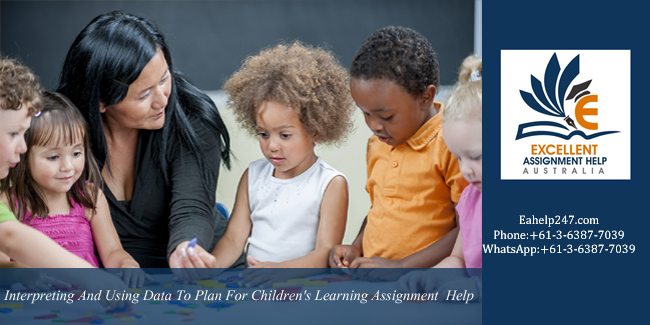Subject Code :- EDMA500
Title :- Interpreting And Using Data To Plan For Children’s Learning
Assessment type :- Report and learning matrix
Individual/group assessment :- Individual
Word count/time limit :- 2,750 words (+/- 10%)
Weighting :- 50%
Assessment description :- Assessment 2 requires you to analyse interview data about one child/student in an early learning environment 3-5-year-olds OR primary school 6-12-year-olds for the purpose of assessing the child/student’s conceptual development of the content areas of Whole Number (with a focus on counting, place value, additive thinking and multiplicative thinking as addressed in state and/or national pedagogical/curriculum documentation relevant to this unit. You are required to interpret the data about the child/students under standings and proficiencies with in the chosen content area and form judgements about their mathematical development with reference to a theoretical framework and curriculum progression.
EDMA500 Interpreting And Using Data To Plan For Children’s Learning Assignment 2

Summarise the data and make judgements about the student’s mathematical understanding in a report with the audience of that report being an in-service teacher. Referring to the student’s report propose recommendations for future learning posed as learning goals and formulate feedback for the student.
In this assessment task you are required to show that you have connected with the messages concerning the principles and practices of effective teaching of the Whole Number do main.
Assessment details :-
In this task you need to choose a data selection group to analyse.
Option 1: Foundation Detour Interview (ages 3-5)
Instructions
To complete this assessment using the Foundation Detour Interview data follow these steps:
Step 1:-
Download the template below.
You will be required to use this template for the FDI record sheet (pp. 1) and the Learning Matrix (pp. 2).
Foundation Detour Interview (children ages 3-5) Template
Step 2:
Review the relevant resources below to support your analysis and interpretation of the data in the FDI record sheet.
Make initial analysis notes using the provided template.
Note:
It is recommended that you download the FDI script and use the FDI record sheet simultaneously as you watch the video presentation below.
Working with the FDI data (3-5 year olds)
FDI record sheet Sara
FDI script

Step 3:
Review the data and use the following categories to help you complete an initial interpretation and conceptual analysis:
A. mathematical understanding (conceptual knowledge)
B. mathematical proficiencies/ways of working and thinking mathematically (procedural knowledge and strategy use)
C. misconceptions or partially constructed understandings or proficiencies
D. concepts and strategies that the child/student could learn next.
Step 4:
Now that you have completed an initial interpretation write data-informed statements about the child’s/student’s mathematical conceptual and procedural knowledge.
You must ensure that you record statements that are backed by the data.
Use the template provided.
Step 5:
Once you have analysed the data:
summarise your statements about the child’s/student’s mathematical understanding in report form in response to your interpretation of data provide feedback and propose recommendations for future learning for the child/student (write these as learning goals).
Step 6:
Develop a targeted teaching and learning matrix for mathematics.
Use the template to ensure that your matrix includes all relevant details that effective teachers attend to when planning for teaching and learning.
Include research guided recommendations for a subsequent teaching and learning matrix including:
A. links to pedagogical and curriculum documentation
B. provisioning the learning environment
C. curriculum decision making (student-centred learning)
D. a variety of resources (including ICT, manipulatives, games and tasks)
E. mathematics-focused learning intentions (concepts and proficiencies).
Step 8:
Create a reference list that shows your engagement in mathematics education literature to inform your work with this assessment task and that acts as a record of your pedagogical reasoning.
If you have questions related to your assessment task, remember to post these in the FDI Discussion Board forum.
EDMA500 Interpreting And Using Data To Plan For Children’s Learning Assignment 2
Option 2: Mathematics Assessment Interview
Instructions :-
Note:
These instructions are relevant to MAI: Mathematics Assessment Interview (6-12 year olds).
To complete this assessment, follow the steps below:
Step 1:
Download the template below. You will be required to use this template for the MAI record sheet (pp. 1) and the Learning Matrix (pp. 2).
Mathematics Assessment Interview (6-12 year olds) Template
Step 2:
Review the relevant resources below to support your analysis and interpretation of the data in the MAI record sheet.
Make initial analysis notes using the provided template.
Note:
It is recommended that you download the MAI script and use the MAI record sheet simultaneously as you watch the video presentation below.
Step 3:
Review the data using the following categories to help you complete an initial interpretation:
A. mathematical understanding (conceptual knowledge)
B. mathematical proficiencies/ways of working and thinking mathematically (procedural knowledge and strategy use)
C. misconceptions or partially constructed understandings or proficiencies
D. concepts and strategies that the child/student could learn next.
Step 4:
Now that you have completed an initial interpretation, write data-informed statements about the child’s/student’s mathematical conceptual and procedural knowledge. You must ensure that you record statements that are backed by the data. Use the template provided.
EDMA500 Interpreting And Using Data To Plan For Children’s Learning Assignment 2
Step 5:
Once you have analysed the data:
summarise your statements about the child’s/student’s mathematical understanding in report form in response to your interpretation of data provide feedback and propose recommendations for future learning for the child/student (write these as learning goals).
Step 6:
Develop a targeted teaching and learning matrix for mathematics. Use the template to ensure that your plan includes all relevant details that effective teachers attend to when planning for teaching and learning.
Include research guided recommendations for a subsequent teaching and learning matrix including:
A. links to pedagogical and curriculum documentation
B. provisioning the learning environment
C. curriculum decision making (student-centred learning)
D. a variety of resources (including ICT, manipulatives, games and tasks)
E. mathematics-focused learning intentions (concepts and proficiencies).
Step 8:
Create a reference list that shows your engagement in mathematics education literature to inform your work with this
assessment task and that acts as a record of your pedagogical reasoning.
If you have questions related to your assessment task, remember to post these in the MAI Discussion Board forum.
Tips
In summary your response to Assessment Task 2 should consist of:
Data Analysis (~150 words)
Discuss the data gathered using the following headings – initial analysis, hunches, and thoughts (dot points in a table)
Data-informed Report for an In-Service Teacher (~400 words)
In this section summarise the child’s mathematical conceptual and procedural knowledge supported by evidence within the data.
Use your notes from above in this section.
Learning Goals and Feedback for Child (~200 words)
In this section plan learning goals for the child Ensure that learning goals focus on both conceptual and procedural development Write these for the in-service teacher. Record feedback statements for the child that are informative for the child. Write these for the child using the feedback frame works explored in the EDMA500 unit.
Targeted Teaching and Learning Plan (~2000 words) (not including template titles)
In this section use colour coding to link your decisions with the requirements of the teaching and learning plan.
Use the teaching and learning plan (matrix) appropriate to your chosen field.
EDMA500 Interpreting And Using Data To Plan For Children’s Learning Assignment 2

a reference list for the entry using APA 7th referencing style
appendices including task details resources templates etc. (if required).
Note:
We are not requesting individual lesson plans.
We are looking to see practices in planning a sequence of learning experiences in response to the data you generated and analysed. You are encouraged to use the resources shared with you in EDMA500 as well as the set readings. Generating a sequence of learning experiences is an expectation for you when you complete the Graduate Teacher Performance Assessment (GTPA).
EDMA500 is preparing you for this high-stakes assessment task that you will complete after your final placement that forms part of your course. Please do not use resources from Twinkl Teachers Pay Teachers P interest or other websites (especially do not use tasks that focus on drill and practice or rely on the completion of worksheets). We are looking for you to plan a sequence of learning experiences that have children/students actively involved in their learning guided by the practices principles and philosophies as advocated for in EDMA500.
Unit learning outcomes
This assessment is linked to the following learning outcomes:
ULO 1:
Demonstrate informed conceptions of current directions in mathematics and numeracy education including culturally responsive and socially critical perspectives by drawing on relevant research the Early Years Learning Frame work the Australian Curriculum: Mathematics and other state and national policy and curriculum documents
ULO 2:
Apply theories and research about early childhood and primary school students’ development of mathematical content and proficencies to create powerful learning experiences including the use of digital technologies for students in whole number measurement and geometry as required by Australian Curriculum: Mathematics and other relevant curriculum documents.
ULO 3:
Analyse the Early Years Learning Frame work and the Australian Curriculum: Mathematics and the effectiveness of different theories and approaches to teaching mathematics that cater for students across a full range of abilities including formative and summative assessment and diagnostic uses of assessment data to articulate and apply pedagogies and approaches to support students’ diverse learning needs.
ULO 4:
Use language symbols visual representations and other resources including digital technologies as tools to design learning sequences and organise lesson activities to support students’ mathematical learning of whole number measurement and geometry as outlined in relevant documents.
Excellent Assignment Help
We Aim At:
- Lowest Price.
- 100% Uniqueness.
- Assignment Fastest Delivery.
